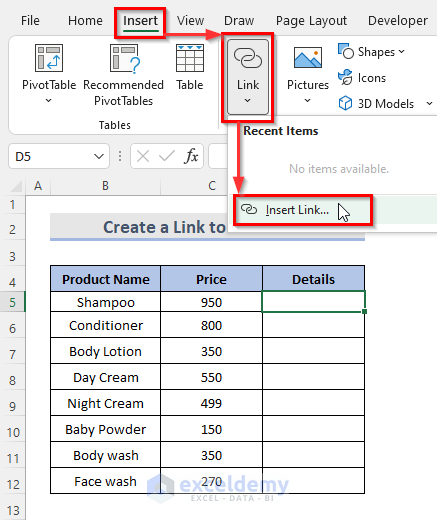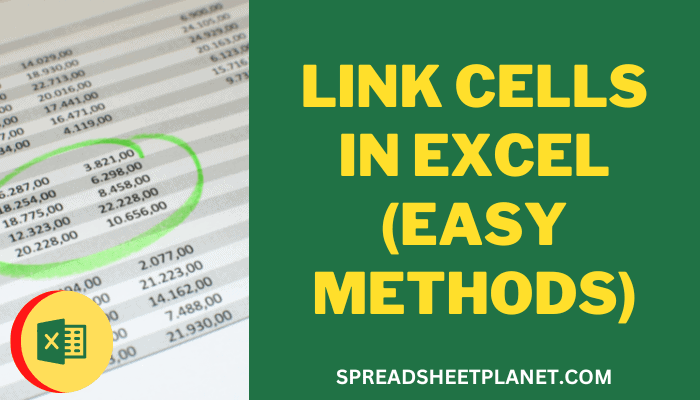5 Ways to Link Excel Cells Between Sheets Easily

Linking cells between sheets in Excel can drastically enhance your data management efficiency, allowing for dynamic updates and consistent reporting. In this comprehensive guide, we will explore five efficient methods to connect cells across different sheets, which not only improves your workflow but also ensures data integrity across your spreadsheets.
Understanding Sheet References in Excel

Before we dive into linking cells, understanding how Excel references work is crucial. Excel uses a system where:
- Sheets are identified by their name followed by an exclamation mark (!).
- Cells within sheets are referenced by their column letter and row number.

🔗 Note: Sheet references in Excel are case-insensitive but must match the sheet name exactly.
Method 1: Direct Cell References

The simplest way to link cells is through direct references. Here’s how:
- Go to the cell where you want the linked data to appear.
- Type an equal sign (=) to start the formula.
- Click on the sheet tab you wish to reference.
- Select the cell you want to link to.
- Press Enter to complete the formula.
This method is intuitive, and the formula would look like:
=Sheet2!A1
🚨 Note: If you rename the sheet, you must update the references manually unless you use absolute references or Excel’s indirect function.
Method 2: Using Named Ranges

Named ranges can make your formulas more readable and easier to manage:
- Select the cell or range you want to name.
- Go to the Formulas tab and select “Define Name”.
- Type in the name you want to use for this range.
- Now, in any cell on any sheet, you can reference this range by its name, like so:
=MyNamedRange
💡 Note: Using named ranges reduces errors and makes formulas easier to understand at a glance.
Method 3: Using VLOOKUP with Sheet References

VLOOKUP is especially useful for matching data between sheets:
=VLOOKUP(A2, Sheet3!A2:D100, 2, FALSE)
Here:
- A2 is the lookup value on the current sheet.
- Sheet3!A2:D100 is the reference table on Sheet3.
- 2 indicates the column from which to retrieve the data.
- FALSE specifies an exact match.
⚠️ Note: VLOOKUP requires the first column of the reference range to contain the lookup values, and it will only search from left to right.
Method 4: Excel’s INDIRECT Function

The INDIRECT function can dynamically refer to another sheet:
=INDIRECT(“‘SheetName’!A1”)
Where:
- ‘SheetName’!A1 is the dynamic reference.
This method allows you to:
- Use formulas that change based on the value in another cell.
- Easily update references when sheets are renamed or moved.
📌 Note: INDIRECT can slow down calculations if used extensively because it recalculates every time the workbook changes.
Method 5: Utilizing the Consolidate Tool

The Consolidate tool is perfect for summarizing data from multiple sheets:
- Go to the Data tab and select “Consolidate”.
- Choose the function you want (Sum, Average, etc.).
- Add references from various sheets by selecting each cell or range and choosing “Add”.
You can use this to link data across sheets, automatically updating when source data changes:
| Function | Description |
|---|---|
| Sum | Adds all numbers in the referenced cells. |
| Average | Calculates the mean of the numbers. |
| Count | Counts the number of cells containing numbers. |

📈 Note: Consolidation can become complex if the data structure in each sheet varies significantly.
By mastering these methods, you're equipped to create dynamic, interconnected spreadsheets that update automatically. This not only saves time but also ensures that your data remains accurate and synchronized across multiple sheets. Remember, each method has its unique benefits and applications, so choose the one that fits your current scenario best. Whether you're setting up links for a financial model, tracking project progress, or managing inventory, linking cells between sheets in Excel can revolutionize how you manage and interpret your data.
What are the benefits of linking cells between sheets?

+
Linking cells ensures that changes in one sheet automatically update related data in other sheets, reducing the need for repetitive manual updates and minimizing errors.
How do I link cells dynamically?

+
Using the INDIRECT function allows you to create dynamic links that update when sheet names or cell references change, offering flexibility in your data management.
Can VLOOKUP reference other sheets?

+
Yes, VLOOKUP can reference other sheets by including the sheet name in the reference like ‘SheetName’!range.
What if I rename or delete a linked sheet?

+
Renaming or deleting sheets will break links unless you’re using dynamic references like INDIRECT, which requires updating. Regularly check for #REF! errors and update your references accordingly.



